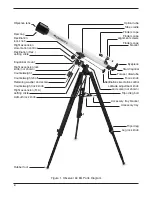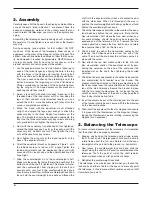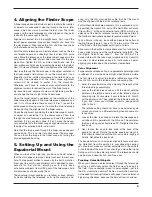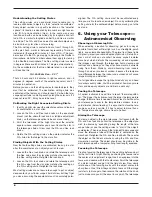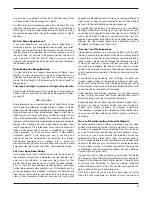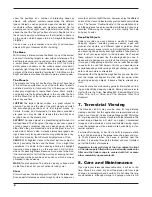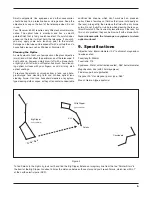
show the positions of a number of interesting deep-sky
objects, with different symbols representing the different
types of objects, such as galaxies, open star clusters, globu-
lar clusters, diffuse nebulas, and planetary nebulas. So, for
example, your atlas might show a globular cluster sitting just
above the lid of the “Teapot” pattern of stars in Sagittarius. You
then know to point your telescope in that direction to home in
on the cluster, which happens to be 6.9-magnitude Messier
28 (M28).
You can see a great number and variety of astronomical
objects with your Observer 60 EQ, including:
the Moon
With its rocky, cratered surface, the Moon is one of the easiest
and most interesting targets to view with your telescope. The
best time to observe our one and only natural satellite is during
a partial phase, that is, when the Moon is NOT full. During
partial phases, shadows on the surface reveal more detail,
especially right along the border between the dark and light
portions of the disk (called the “terminator”). A full Moon is too
bright and devoid of surface shadows to yield a pleasing view.
the Planets
The planets don’t stay put like the stars (they don’t have fixed
R.A. and Dec. coordinates), so you’ll have to refer to charts
published monthly in Astronomy, Sky & Telescope, or other
astronomy magazines to locate them. Venus, Mars, Jupiter,
and Saturn are the brightest objects in the sky after the Sun
and the Moon. Not all four of these planets are normally visi-
ble at any one time.
JUPITER The largest planet, Jupiter, is a great subject to
observe. You can see the disk of the giant planet and watch
the ever-changing positions of its four largest moons, Io,
Callisto, Europa, and Ganymede. If atmospheric conditions
are good, you may be able to resolve thin cloud bands of
varying hues on the planet’s disk.
SATURN The ringed planet is a breathtaking sight when it is
well positioned. The tilt angle of the rings varies over a period
of many years; sometimes they are seen edge-on, while at
other times they are broadside and look like giant “ears” on
each side of Saturn’s disk. A steady atmosphere (good see-
ing) is necessary for a good view. You may probably see a tiny,
bright “star” close by; that’s Saturn’s brightest moon, Titan.
VENUS At its brightest, Venus is the most luminous object in
the sky, excluding the Sun and the Moon. It is so bright that
sometimes it is visible to the naked eye during full daylight!
Ironically, Venus appears as a thin crescent, not a full disk,
when at its peak brightness. Because it is so close to the Sun,
it never wanders too far from the morning or evening horizon.
No surface markings can be seen on Venus, which is always
shrouded in dense clouds.
MARS You probably won’t be able to see any surface detail
on the Red Planet, but you will notice its ruddy color.
stars
Stars will appear like twinkling points of light in the telescope.
Even powerful telescopes cannot magnify stars to appear as
more than points of light! You can, however, enjoy the different
colors of the stars and locate many pretty double and multiple
stars. The famous “Double-Double” in the constellation Lyra
and the gorgeous two-color double star Albireo in Cygnus are
favorites. Defocusing the image of a star slightly can help
bring out its color.
Deep-sky objects
Under dark skies, you can observe a wealth of fascinating
deep-sky objects, including gaseous nebulas, open and
globular star clusters, and different types of galaxies. Most
deep-sky objects are very faint, so it is important that you find
an observing site well away from light pollution. Take plenty of
time to let your eyes adjust to the darkness. Don’t expect
these subjects to appear like the photographs you see in
books and magazines; most will look like dim gray smudges.
(Our eyes, unlike photographic film, are not sensitive enough
to see color in such faint objects.) But as you become more
experienced and your observing skills get sharper, you will be
able to discern more subtle details.
Remember that the higher the magnification you use, the dim-
mer the image will appear. So stick with low power when
observing deep-sky objects, because they’re already very
faint.
Consult a star atlas or observing guide for information on find-
ing and identifying deep-sky objects. Some good sources to
start with are the Orion DeepMap 600, Edmund Mag 6 Star
Atlas, Turn Left at Orion, and The Universe From Your
Backyard.
7. terrestrial Viewing
The Observer 60 EQ may also be used for long-distance
viewing over land. For this application we recommend substi-
tution of an Orion 45° Correct-Image Diagonal (#8790) for the
90° star diagonal that comes standard with the telescope. The
correct-image diagonal will yield an upright, nonreversed
image and also provides a more comfortable viewing angle,
since the telescope will be aimed more horizontally for ter-
restrial subjects.
For terrestrial viewing, it’s best to stick with low powers of 50x
or less. At higher powers the image loses sharpness and clar-
ity. That’s because when the scope is pointed near the
horizon, it is peering through the thickest and most turbulent
part of the Earth’s atmosphere.
Remember to aim well clear of the Sun, unless the front
of the telescope is fitted with a professionally made solar
filter and the finder scope is covered with foil or some
other completely opaque material.
8. care and Maintenance
If you give your telescope reasonable care, it will last a life-
time. Store it in a clean, dry, dust-free place, safe from rapid
changes in temperature and humidity. Do not store the tele-
scope outdoors, although storage in a garage or shed is OK.
8


